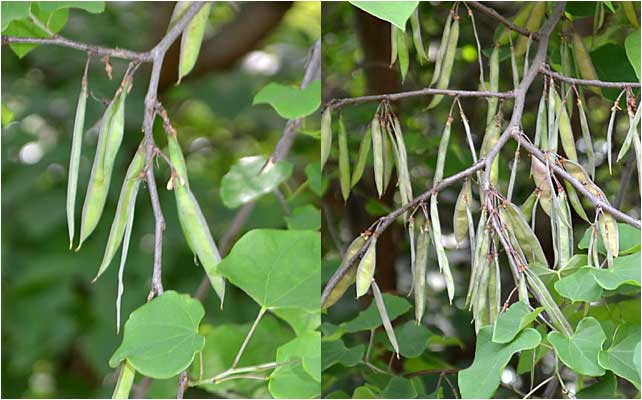38. RED BUD, Cercis canadensis

Red Bud is native to our region, and justly known for its spectacular color in Spring. Because it opens so early in the Spring, it is also a very important source of nectar and pollen for pollinating insects. At a time when both are scarce.
SPRING, THE "BUD" IN RED BUD

These are the actual flower buds of Eastern Red Bud as they first appear in Spring (left). Fairly soon, however, they begin to open and flower (right). As the Red Bud opens, it also reveals the true purpose of the flower - reproduction.
SPRING, PERFECT FLOWERS

The Red Bud is a monecious tree (male and female on same tree) but takes it a step further. It has PERFECT FLOWERS - flowers that contain both male and female parts. We see this clearly in this image of opening Red Bud flowers. The male stamens have pollen filled pods at the end of their filaments. The longer, singular female stigma receives the pollen. While capable of self-pollinating, pollination by other trees is always encouraged in nature. Each tree achieves this diversity by releasing pollen and nectar at different times, and by timing that the stigma is not receptive when the flowers own pollen is being dispersed.
SPRING, FULL FLOWERS

The full bloom of the flowers of Eastern Red Bud, early Spring. The full leaves will not appear until the very end of the flowering period.
SUMMER FOLIAGE & LEAF

During flowering, the new leaf growth starts (above, inset) and then develops into full summer foliage (left). The leaf of Red Bud is attractive - nearly round at times, heart-shaped at others - depending on how much sun it receives.
SUMMER, FALL: FRUIT

During Summer the Red Bud produces this fruit pod (left) - eagerly anticipated by wildlife in the Fall (right). The pods darken to a near purple color in Fall during fall foliage.
FALL FOLIAGE

While not as spectacular a fall performer as Shagbark Hickory, the Red Bud holds its own during Fall. Look close for the fruit, they provide good contrast to the yellow foliage as well as being a magnet for birds and wildlife.
WINTER

Winter is a wonderful time to reflect on the shape and strategy of trees. What started as an original planting (Douglas Jackson, 2008) has grown into a small stand. The seed pods of Red Bud fall to the ground and will grow additional trees - forming a group of Red Buds. Given its importance as a keystone environmental, Red Bud makes an excellent replacement for non-native early blooming trees in the CT landscape.